Also known as “Fowlers Magic Dragon”, “Puff the Magic Dragon”, or just “the Puff”, but most likely not known at all.
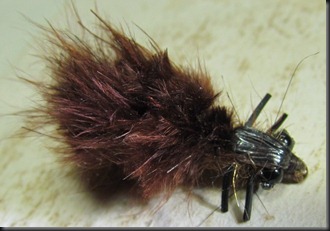
I suppose I have done very little to spread the news about this fly, but that was borne out of a desire not to be pretentious about the thing, rather than any motivation to keep the pattern to myself.
This fly is a catcher of fish in stillwaters in South Africa. And a catcher of some large fish too.

Herman Botes excellent “Papa Roach” of more recent years can safely boast the same prowess. Maybe good Dragonfly patterns are catchers of large fish, period.
This fly pattern started off life in the mid 1980’s. It was inspired by two flies. The first was “Clayne Baker’s swimming nymph”.
This was a pattern that had been demonstrated by Tom Sutcliffe, Don Robertshaw, and Hugh Huntley, at one of a series of fly tying classes presented in the early eighties at the Imperial Hotel in Maritzburg. These were the heydays of fly fishing. Africa’s first, and at that stage, only, fly-shop had just opened in town, and there was a buzz. Classes were put together firsts in 1981 under the banner of the Natal Fly-fishers Club (founded 1972) and then in 1983 under the banner of the Natal Fly Dressers Society.
I was a schoolboy at the time, but by kind favour of Brian Barry, a bunch of us kids were taken to these monthly meetings in his million mile Mercedes. He parked this mighty swaying ship in the “No Stopping” zone directly in front of the Loop Street police station opposite the hotel, and left it there with a dignified impunity,claiming that he had the perfect defence if ever challenged by the law: he was from “Rhodesia”!
The tying lessons were held in a room off the courtyard. It was one of those traditional hotel meeting rooms, with plush carpets, high ceilings and sash windows. As schoolboys we must have been somewhat wide-eyed. We were amongst men, and waiters whirled in and out between jokes that we didn’t fully understand, and tales of fly-fishing in which we immersed ourselves with delight. There were notes. I still have them. They were produced on an odd size paper, somewhat long and narrow, and they were hand written, with sketches, and copied on a roneo machine. Remember those?
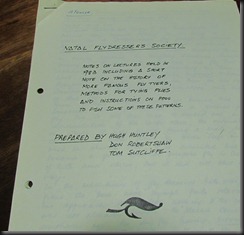
Clayne Baker’s “nymph that swims” was one made almost entirely of marabou. Marabou was the wonder material of the day…a bit like CDC in later years, or UV glue nowadays. This fly used only marabou, applied in clever ways. The eyes were knotted marabou, and the whole fly pulsed and moved in the water. I seem to remember someone dropped one in their whiskey to make this point. That impressed the schoolboys!
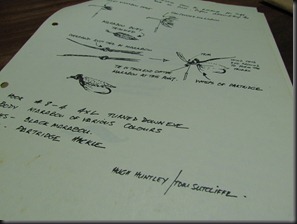
Just a few years later, I found myself at University, in the company of some very creative fly-tiers and fishermen. Paul DeWet, Brett Coombes, Andy Krajewski. At the time, I would imagine that Randall Kaufmann’s book was still fairly hot off the press. I would imagine that it was this that inspired Andy Krajewski to attempt a floating Dragon. But Andy decided to give the thing an African representation, so he used Duiker hair instead of deer hair. I suspect that as a varsity student, road-kill was preferable to store bought materials, based on the only dimension that mattered: budget.
So enter fly number two: Andys Duiker hair dragon.
The thing caught fish hand over fist, and it was all about the shape. I still have a very clear picture in my mind as to how it was trimmed: the “fuselage” of the dragon nymph was beautifully represented. I studied the “cut” with care, and took it on board.
Then I decided to try to incorporate the movement of the Marabou, with the shape of the duiker hair.
Marabou doesn’t spin of course, so I tied the stuff as Clayne Baker had done in small bunches at points all around the shank. Half a packet of marabou later (We tied these fellows big. Still do.), and you had a huge hairy mess. Tie off the silk, and set about trimming it to get Andy’s perfect dragon shape.
The first entry in my logbook that mentions the fly, calls it a “Clayne Baker dragon”. It slaughtered the South African Trout! There was no question that it was a winner.
Minor adjustments followed: The marabou eyes were replaced with black Tuff-chenille loop eyes (inspired by Hugh Huntley’s Red Eyed Damsel, which was making waves back then)
It got a collar of soft speckled partridge feather for legs (it is still hard to beat this part)
And we dubbed the thorax, putting a Swiss straw (Raphine) thorax cover over.
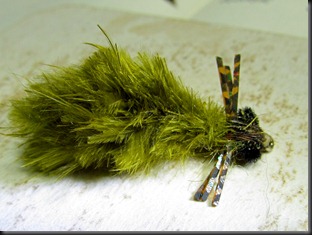
And then we fished it. And fished it plenty. And did plenty well.
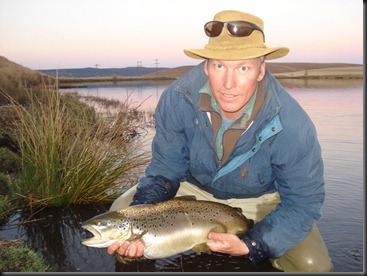
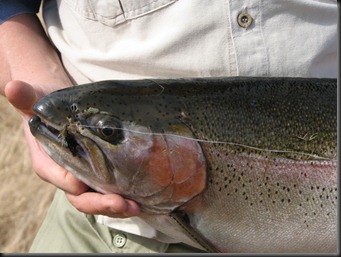
Skips a few years, and our good friend Brett Coombes left South Africa for OZ.
Unbeknown to me he smuggled a few of these Dragons into Australia. (And you thought their border control was good!)
A few years later, Brett sent me a delightful story. It seems that a friend of his, who ran a fly store in Western Australia had seen the pattern, and asked if he could copy it. Brett obliged, with one condition: that it be named after me , and he gave the name “Fowler’s Magic Dragon”.
The fly was duly copied and sold in the shop. On one occasion, Brett told me, a visiting fly-fishing team bought a few of the flies to use in a competition that was taking place in town. They used the dragon to good effect, and won the competition hands down. After this the fly shop started getting the flies tied in bulk by their supplier in Zimbabwe.
The story dies there. I don’t know what became of the FMD in Western Australia.
All I know is that a whole lot of them still live in my fly box, that I tie one on most times when fishing a stillwater, and that it accounts for more big Trout than anything else I have ever fished.
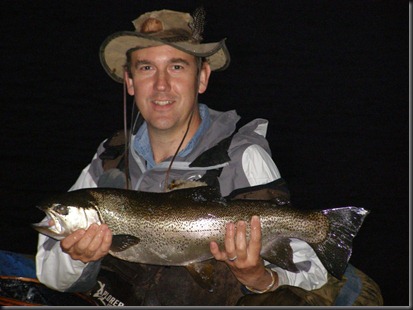
And I suspect that there are only 3 or 4 people in the world that fish it.
The other day a fellow blogger saw a picture of one of my fly boxes, and encouraged me to share the recipe. So here it is. The FMD:
Hook: Nymph hook, heavy wire, from #8 to #2.
Weight: several wraps of lead wire. Not too much in the larger sizes: this fly is not easy to cast as it is!
Body: Marabou in olive, brown or black, tied in small clumps all the way up the shank to the thorax. Tie off at this point and trim the marabou with care as per the following shape sketch:
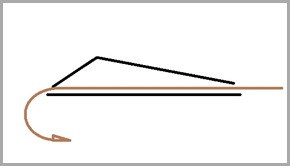
And have a look at a real dragonfly nymph to get an idea of size and shape:
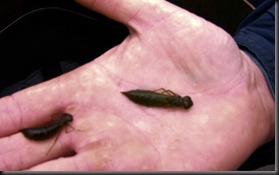
Legs: a single turn of speckled partridge. Alternatively you may elect to use small rubber legs, or even amber coloured V-Rib.
Thorax: SLF and seals fur blend, in a colour darker than the body
Thorax shell/cover: Swiss straw, Turkey, or scud back, again, in a darker colour than the body
Eyes. Tied well forward: plastic beads, looped tuff chenille or similar, but either way, they must be prominent.
The FMD pictured wet to appreciate the shape you should be aiming for:
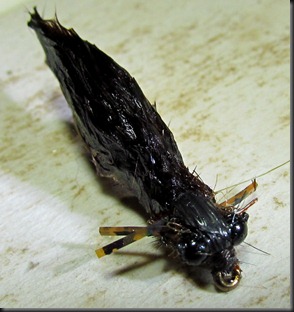
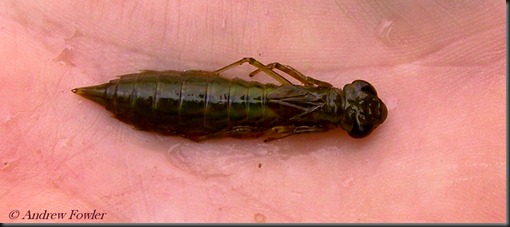
Fishing the FMD:
Broadly speaking we use olive in summer, and dark brown in winter. Dragons spend a lot of time crawling along structure. Until someone masters creeping an imitation along the side of a log, this means retrieving it along the bottom, regardless of how deep or shallow that may be. So we weight the fly and get it down. However, being a big piece to throw (and yes, I do regularly fish them in #2 long shank), you don’t want too much lead in there, especially if you place a value on that sensitive spot in the back of your neck where flies do sometimes make ground fall in a wind. Retrieve: always very slow. Maybe with the odd burst in there to mimic the micro jet propulsion that dragons are capable of, but not at the expense of it being a slow retrieve.
In deep water I use a sinking line, but more often than not it will be on the end of an intermediate, and at times, in the shallows, on a floater.
It lands with the subtlety of a B52 without wings, so cast it seldom by retrieving it slow.
And hang on tight!
February 2014: Following a number of requests, I have produced a short clip, demonstrating the tying of the fly. It can be found here:
https://vimeo.com/86880125
30 Responses
At first sight I thought, “What on Earth is that?” Then, I saw it wet and the answer to my question was, a brilliant pattern! …a B-52 without wings… hahaha
Thanks. It does seem to be a pattern that has earned its stripes (or is that wings?) ……..
A nice bit of fly-fishing history in this tale. Fly looks like a killer. Do dragon nymphs move at night, too?
I am not entirely sure about that, but I suspect they do, and one of the large fish pictured was caught after sundown.
Great fly. I can think of a number of lakes this would work on. Thanks!
Thanks for reading.
Delightful post. What a pleasure to read even for a non-fisherman 🙂
My thoughts on this fly are all good and I will stepping over to the vise for a session to build a bunch of these for an outing in the very near future to a still water that produces some fairly large trout.
Tight lines!
I tied this fly over the weekend, will be using it over next weekend! I found it faster to tie if you use a dubbing loop with the marabou body
The dubbing loop is a great idea! Thank you.
Pleasure, I will let you know how it works over the weekend, will be fishing it at Fernbank and Fancy Free close to Machadadorp. I tried the dubbing loop as I thought it would speed up the tying process just need to stroke back decently after each turn. I also tied in the fly the other way around. I tied in a tail then wind forward tie in plastic bath chain eyes (same as papa roach) the tied in the wing case at the eye, then continued to tie in legs and dubbing. Pulled the wingcase back an tie off. I then use lead wire to secure all legs out of harms way. Then I take my thread back to the tail, form the dubbing loop, wind forward until I reach the wingcase then tie it off and whip finish this virtually leaves no trail of any thread. Then I trim to shape and remove lead wire
I just love the look of the fly when it is wet! Great profile!
Tight lines!
That looks absolutely fabulous! I have searched for an imitation like this that didn’t take all day to tie for years and this absolutely looks to fit the bill. If I am successful copying it, I think it will become a secret weapon in rivers also! Any chance that you might make a video of you tying one?
I am glad you found it Jerry. I will most certainly look at making a short video on how to tie it.
I have just uploaded a video of how to tie this fly, on both Vimeo :
https://vimeo.com/86880125
and on You-tube.
https://www.youtube.com/watch?v=SZcrpuieYaY
The link appears at the foot of the post itself, above.
Thanks so much!
A Pleasure…I do hope it gives you enough detail.
I have already made up a half dozen from your description. Now to watch the video and fine tune them. Pic to follow 🙂
Marvelous video! Just what I was hoping for! I used an old #6 Mustad 79580 nymph hook as I think it wil be the perfect size. As it turns out, I had stumbled upon the right kind of marabou plumes and how to attach them before hand! I did add partridge legs. You can see my copies here if you want. I have high hopes for them!
http://s197.photobucket.com/user/jplaaten/media/P2180019_zps57ff301c.jpg.html
Many years ago when I first became interested in trout, about the greatest bait that one could use for them was “perch bugs”. If a trout was within 100 yds, it seemed it would find the bait. It was quite some time before I found out that they were dragonfly nymphs.
Another magical time with them occurred a few years back when I was camped on a small island in the Beaverkill River at what was Twin Islands Campsite in New York State. There were quite a few dragonflies around all of a sudden it seemed at some motion in the grass near the bank caught my eye. There were many dragonfly nymphs crawling up the grass blades and emerging from their skins! I was a wondrous thing to see and watch!
So thanks again for your pattern and video! I will make certain that credit is given when I share it with my friends. I think I need to pack a bit more marabou on and practice my trimming just a bit! Many thanks…
Jerry Plaaten
Green Cove Springs, FL USA
Those nymphs look great Jerry!
I was lazy in the video, and didn’t put the partridge legs in, but in fact that is exactly what it usually has. More recently I have “bitch creeked it” as my Ausie friend Brett says, by using rubber legs.
I also often use Raphia/raphine or “nymph skin” as the thorax cover. And there are various options for eyes. The original had looped tuff chenille eyes.
Others have suggested doing the marabou in a dubbing loop, which would also work….I need to try that, but I suspect it may not pack the marabou as thickly as I like.
Speaking of “perch bugs”, I am told the Australian call them “mud-eyes”.
Cheers for now.
Andrew
It’s up there as one of the top patterns I’ve seen in a long time. I’m sure it works better than the p-roach and other lake dragons. I’m very busy and don’t get time to tie anymore. Where can I purchase a few.
Thanks Peter. The Papa Roach is an excellent pattern and I wouldn’t even try to pitch one against the other, but would rather just carry both in my box. Although I must say, having had so much success on the FMD since the 1980’s, I put that one on first out of habit.
I am not aware of anyone tying them commercially, so I can’t advise where to buy some I am afraid, Perhaps a commercial tier would like to “rise to the bait”?
Nice looking fly, I will give it a try.